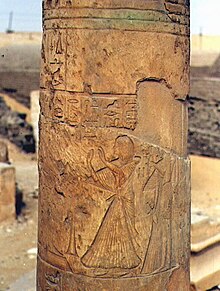Life
She was born in the reign of Horemheb into a non-royal family, before her grandfather Paramessu (later Ramesses I) ascended to the throne. It is possible she was named after her grandmother, who is known as Sitre, but could be identical with a woman named Tia, who was named as Seti's mother. [3] Her only known sibling is Pharaoh Ramesses II; a younger princess called Henutmire was either her sister or her niece. [4] [5]
Since she was not born as a princess, she is one of the few princesses during Egypt's history, who married outside the royal family. Her husband, a royal scribe, was also called Tia and was the son of a high-ranking official called Amonwahsu. [6] Tia, son of Amonwahsu was Ramesses' tutor, and held important offices later in his reign, he was Overseer of the treasuries, and Overseer of the Cattle of Amun. [5] [7] Princess Tia, similarly to other noble ladies, held titles which indicate she took part in religious rituals ("Singer of Hathor", "Singer of Re of Heliopolis", "Singer of Amun-great-in-his-glory"). [5]
Tia and Tia are depicted on a stone block, together with Queen Tuya (this is now on display at the Royal Ontario Museum in Toronto). Another stone block, now in Chicago, shows Tia (the husband) with his father Amonwahsu, Pharaoh Seti I, and Ramesses II as crown-prince.
This page is based on this
Wikipedia article Text is available under the
CC BY-SA 4.0 license; additional terms may apply.
Images, videos and audio are available under their respective licenses.
